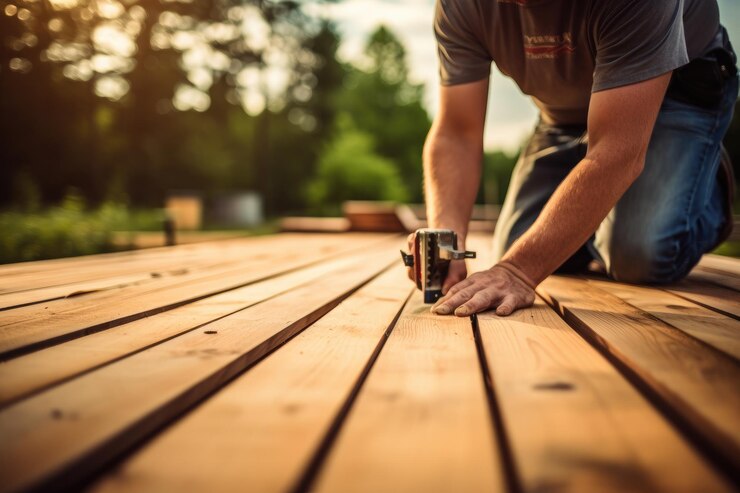
A deck provides a fun, comfortable space for family and friends to socialize, enjoy al fresco dining or barbecues, or simply relax with a cup of coffee. A deck is also a valuable asset to any property and has a high resale value.
When broken down into smaller sub-projects, building a basic deck does not have to be difficult. Working slowly and thoroughly through the process allows you to build the deck safely and with no room for error.
Stages of Basic Deck Construction
- A basic square or rectangular deck is attached to the house’s side. A ledger board is attached to one side of the deck to ensure a strong attachment to the house’s structural members.
- A heavy beam supports the opposite side of the deck. The beam runs parallel to the house and is supported by vertical posts. Concrete footings sunk into the ground support the posts.
- The ledger board is one of the four sides of the deck’s outer framework. One header joist parallel to the house and two outer rim joists perpendicular to the house form the other three sides.
- Wood floor joists run perpendicular to the house within this framework.
- Deck floorboards are attached to the joists at the top.
- Outside of the house, a staircase leads to the deck.
- The addition of a railing to the deck increases its safety. Handrails are required around the deck perimeter and along the stairs on elevated decks with stairs.
Permits and Codes
In most cases, a permit for an attached, elevated deck must be obtained from the local permitting office. One advantage of constructing a detached ground-level or floating deck is that it frequently does not require a permit as long as it is less than a certain height, which is usually 30 inches.
In contrast, the deck on this project is attached to the house, a condition that usually necessitates permitting. Railings and balusters are also required because the deck can be built higher.
Contact your local underground utility locating service and have them perform a site inspection of the proposed area before digging any holes.
When Should You Build a Deck?
Early autumn is a great time to build a deck, especially if you hire a professional. Around that time, builders’ job orders tend to decline. Because the ground isn’t frozen, it’s easy to work with. In most areas, temperatures have dropped and it has remained dry. If the deck is finished in the fall, it will be ready for use the following spring.
However, as a do-it-yourselfer, building the deck in autumn may put you under pressure to finish before winter arrives. So, if you don’t mind missing out on a couple of weeks of deck use, starting the deck build in late spring will mean longer workdays and drier, warmer weather.
Prior to Beginning
A back or side door should lead to the deck from the house. Never build a deck that is flush with the height of the house’s flooring. Instead, reduce the height of the deck by at least 3 inches.
The deck site should be level and free of large ground obstructions such as tree roots. Clear the area to the intended size of the deck, plus an additional 6 to 8 feet for working.
Deck Building Prices
A small attached deck built by yourself with pressure-treated wood floorboards will cost between $1500 and $5,500, depending on size.
A 300-square-foot professionally built deck with two benches, stairs, and a railing will cost more than $14,500 on average across the United States.
The choice of deck floorboards has a significant impact on the overall cost of the deck. The least expensive option will be pressure-treated wood flooring. Wood composite decking can cost up to four times as much. Tropical hardwood species such as ipe command the highest prices for decking.
Materials for Deck Floorboards
- Pressure-Treated Lumber: Pressure-treated lumber is inexpensive, widely available, and highly resistant to weather and insects. The majority of decks have it as flooring. The disadvantage is that it produces splinters, making it unsuitable for barefoot use. Pressure-treated wood will also crack and warp over time.
- Composite Wood: Made of both recycled and new plastic, as well as wood fibers, composite wood decking never requires staining or coating. It will never split, rot, warp, or splinter. However, because composite wood decking does not span well, the joist spacing must be reduced. Composite wood decking is frequently attached to joists with hidden clips specified by the manufacturer.
- Cedar: Cedar is roughly twice as expensive as pressure-treated wood, but it weathers well due to the oils and tannins it contains. In general, cedar is insect resistant. The stain adheres well to cedar. It does, however, split and splinter like pressure-treated wood.
- Tropical hardwoods: such as ipe, are the most expensive decking materials. Because of their hardness and density, they do not absorb stains well, but they can be oiled to protect them. Tropical hardwoods require special hidden clips to be attached to the joists.
Considerations for Safety
Follow all safety precautions included with the power tools you will be using. When building elevated decks, height can be a safety concern; even a foot or two of elevation can cause injury.
What You’ll Need
cdc
cccc